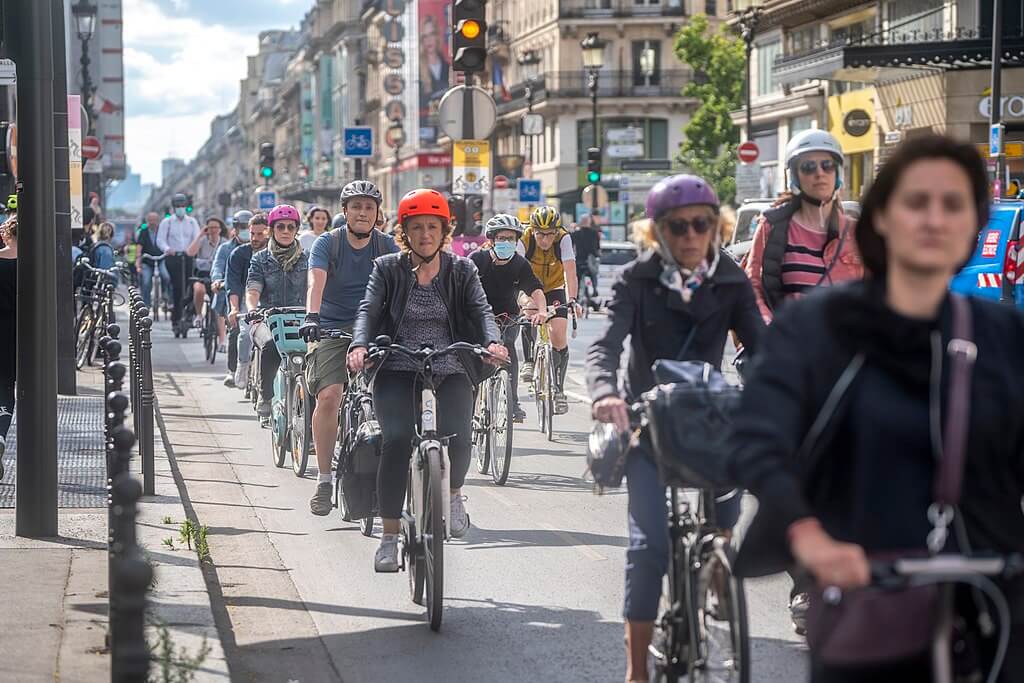Autumn Gear Guide
Find inspiration in our Gear Guide that will keep you out on your bike through wind or rain.
Download NowIt didn’t happen overnight, but Paris is forever changed, and now local residents of the French capital are reaping the rewards. Top of list? Cleaner air. A lot cleaner. Over the past two decades, the French capital has undergone a remarkable transformation — and cyclists are riding at the heart of it. A recent report […]
It didn’t happen overnight, but Paris is forever changed, and now local residents of the French capital are reaping the rewards. Top of list? Cleaner air. A lot cleaner.
Over the past two decades, the French capital has undergone a remarkable transformation — and cyclists are riding at the heart of it. A recent report by Airparif, the independent organization that monitors air quality in the Île-de-France region, delivered the kind of news that would have seemed unimaginable 20 years ago: between 2005 and 2024, levels of nitrogen dioxide and fine particulate matter — two of the most harmful pollutants to human health — have been slashed by 50% and 55%, respectively.
So how did Paris, once choked with vehicle traffic and notorious for its smog, pull off such a turnaround? The answer lies in a bold mix of policies, infrastructure investments, including a cultural shift toward cycling as a preferred mode of transportation.
The city’s cycling revolution didn’t happen overnight. But when Paris mayor Anne Hidalgo took office in 2014, she doubled down on active transportation. She began reimagining the city not as a car-centric hub, but as a “15-minute city” — a place where residents could access most daily needs within a short walk or bike ride from home.
“For each new cycle path, there are always more Parisians who get around!” said Mayor Anne Hidalgo. “Like rue du Renard in Paris Centre, whose new cycle path has quickly attracted new cycling fans.”
Key initiatives like the pedestrianization of the banks of the Seine and the creation of a Zone à Faibles Émissions (Low Emissions Zone) helped set the tone. Alongside these measures came an explosion of bike infrastructure: over 1,000 km of bike lanes now crisscross the city, many of them separated and protected, with entire stretches designated for cyclists and pedestrians only.
These changes dramatically reduced car traffic in central Paris, and Parisians responded in kind. Daily bike trips in the city more than tripled between 2010 and 2022, and the trend only continues upward, with an estimated one million cycling trips per day now recorded in the region.
And it isn’t just cycling. It is about putting people first. The city’s school streets program has also been a massive success transforming entire blocks near schools to allow children and families to get to school by walking or cycling safely not having to drive. What a concept!

Rue de Rivoli in Paris, circa 2020
The impact of this transformation is quantifiable. With fewer combustion engines spewing pollutants into the air, the city has seen a consistent year-on-year drop in harmful emissions. According to Airparif, the combination of regulatory pressure, low-emissions zones, and sustainable transport options — especially cycling — are directly responsible for the improved air quality.
And the benefits are more than just environmental. The study estimates that maintaining and expanding current measures could prevent up to 7,900 premature deaths due to pollution-related illnesses. That’s a staggering figure — and one that underscores the life-saving potential of better urban planning and active mobility.
Still, challenges remain. While pollution levels have fallen across most of the region, areas near major roadways — such as the Périphérique ring road and major highways such as the A1 and A6 — are problem zones. And with stricter EU air quality standards set to come into effect by 2030, some 2.6 million residents (or 20% of the regional population) are projected to still be exposed to harmful levels unless further action is taken.
This means more of what’s already working: more bike lanes, more car-free zones, more public support for active transportation.
Paris’s journey is a masterclass in how a city can reclaim its air, its streets, and its identity through the power of policy — and the pedal. It’s also a timely reminder for other major cities facing their own pollution challenges: if you want cleaner air, start by making space for bikes.
Yes, Paris is not the only example, it is only the most recent. Cities such as Amsterdam, Utrecht and Copenhagen have become the finest examples of bicycle-friendly cities on the planet. Not surprisingly, they are also often credited as being amongst the most livable on the planet, offering a quality of life that is unrivalled.
It can happen. It is well documented that those cities also favored the car for decades but the will of the public won out over time. It can happen in North American cities too where many regions are moving in that direction.
Find inspiration in our Gear Guide that will keep you out on your bike through wind or rain.
Download Now
Leave a comment